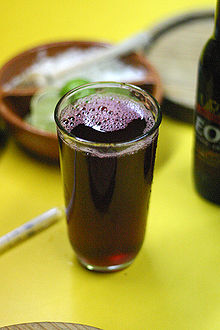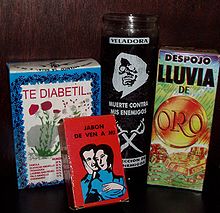- Mexican tea culture
-
Mexican tea culture is known for its traditional herbal teas which are reputed to have medicinal properties. In recent decades, imported tea beverages have also become popular in Mexico. Mexican tea recipes have grown in popularity beyond Mexico as well.
Contents
History
Mexico has numerous indigenous herbs that native cultures used to make teas for centuries before Spanish colonization. Tea varieties from Europe and Asia were not introduced to Mexican agriculture, however, and have yet to reach the level of popularity that they have in many other countries. The climate of Mexico is diverse, ranging from deserts to mountain plateaus and tropical rainforests in the southeast. The southeastern region may be suitable for cultivating imported tea varieties.[1]
A small number of prominent establishments in Mexico City have formal tea rooms, where British-style tea is served, including the Hotel Marquis Reforma and the Presidente Inter-Continental Mexico City hotel.[2]
Herbal teas
Herbal teas are common in Mexico. Many herb varieties, both indigenous and imported, are sold at Mexican markets. There are many traditional herbal teas that are reputed to have medicinal properties. Medical research is being undertaken to attempt to verify any actual medicinal properties that these traditional teas may have. Some herbal teas have been shown to have health benefits, while others have been shown to have none. Traditional medicinal tea use is common in some Mexican immigrant communities in the United States.[3]
Poleo is an herbal tea made from the Lamiaceae Hedeoma drummondii plant. Aside from being used to make a tea beverage in Mexico, this plant has also been used as a culinary spice by native cultures north of Mexico. Poleo has been found to be rich in antioxidants. [4]
Yerba buena is a name given to a variety of mint teas sold loose in many markets. This is similar to yerba mate, used throughout many Latin American countries as mate (beverage), and widely regarded to have health benefits. Mild stomach upset is often remedied with tea made from lemongrass, or Limón.
Traditional Mexican herbal teas should be consumed with great caution, as incorrect doses can be toxic.[5]
Modern teas
See also: agua frescaDried flowers of the flor de Jamaica (hibiscus) plant, used to make agua de Jamaica, or Jamaica iced tea.
Jamaica iced tea is a popular drink made of the flowers and leaves of the Jamaican hibiscus plant (Hibiscus sabdariffa), known as flor de Jamaica in Mexico. It is served cold and quite sweet with a lot of ice. The ruby red beverage called Hibiscus tea in English-speaking countries is called agua de Jamaica (water of Jamaica) in Mexico, where it is widely availble in restaurants and from street vendors.[6]
Chocolate tea
Champurrado is a Mexican chocolate drink, sometimes incorrectly called "Mexican chocolate tea". It is a popular recipe exported to the United States. This drink is made with chocolate and spice with cinnamon. Champurrado is related to xocoatl, which is a traditional Aztec cocoa-bean drink.
References
- ^ "Mexico". Rate Tea. http://ratetea.net/region/mexico/86/. Retrieved October 23, 2011.
- ^ "Tea Rooms". Tea Guide. http://www.teaguide.net/other-t2.htm. Retrieved October 23, 2011.
- ^ "Home Remedies for Type 2 Diabetes Used by Mexican Americans in El Paso, Texas". CLINICAL NURSING RESEARCH. No. 4 12: 304–323. November 2003. doi:10.1177/1054773803256872. http://www.herbalsafety.utep.edu/publications/documents/home_remedies.pdf. Retrieved October 23, 2011.
- ^ "Free radical scavengers from the Mexican herbal tea "poleo" (Hedeoma drummondii).". Zeitschrift für Naturforschung. C, Journal of biosciences 63(5-6):: 341–6.. May-Jun 2008. http://www.ncbi.nlm.nih.gov/pubmed/18669018. Retrieved October 23, 2011.
- ^ "Medicinal plants of Mexico". Sparks Mexico. http://sparks-mexico.com/costalegre/fruit/medicinal-herbs.htm. Retrieved October 23, 2011.
- ^ "Jamaica iced tea". Cooking in Mexico. http://cookinginmexico.com/2011/09/28/jamaica-iced-tea/. Retrieved October 23, 2011.
See also
- Mexican cuisine
- Tea
- Herbal tea
- Agua fresca
- Tepache
- Tejate
- Tejuino
- Traditional medicine
- Health effects of tea
Tea Black tea Oolong tea - Bai Ji Guan
- Red Robe
- Darjeeling Oolong
- Dongding (Tung-ting)
- Dong Fang Mei Ren
- Huangjin Gui (Golden Osmanthus)
- Qilan tea
- Pouchong
- Rou Gui
- Shui Jin Gui
- Shui Hsien (Shui Xian)
- Tie Luohan
- Tieguanyin (Iron Goddess)
Green tea - Aracha
- Bancha
- Green Spiral
- Chun Mee
- Da Fang
- Genmaicha
- Liuan Leaf
- Gunpowder
- Gyokuro
- Hojicha
- Hou Kui
- Huang Shan Mao Feng
- Hyson
- Kabusecha
- Kamairicha
- Konacha
- Kukicha
- Longjing (Dragon Well)
- Matcha
- Mao Jian
- Mecha
- Meng Ding Gan Lu
- Sencha
- Shincha
- Tamaryokucha
White tea Yellow tea Post-fermented tea Blended and
flavoured teasTea culture Tea beverages Other - Camellia sinensis (tea plant)
- Tea bag
- Teapot
- Consumption
- Flowering tea
- Glass-holder
- Health effects
- Tea processing
- Samovar
- Tea brick
- Tea garden
- Tea house
- Tea tasting
- Teakettle
See also Categories:- Tea culture by country
- Traditional medicine
- Mexican cuisine
- Tea by country
Wikimedia Foundation. 2010.



